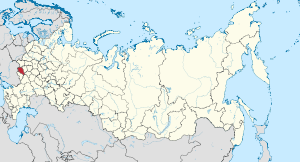Kursk Oblast
|
Kursk Oblast Курская область (Russian) |
|||
|---|---|---|---|
| — Oblast — | |||
|
|||
|
|
|||
|
|||
|
|
|||
| Political status | |||
| Country | Russia | ||
| Federal district | Central | ||
| Economic region | Central Black Earth | ||
| Established | June 13, 1934 | ||
| Administrative center | Kursk | ||
| Government (as of November 2015) | |||
| • Governor | Alexander Mikhaylov | ||
| • Legislature | Oblast Duma | ||
| Statistics | |||
| Area (as of the 2002 Census) | |||
| • Total | 29,800 km2 (11,500 sq mi) | ||
| Area rank | 65th | ||
| Population (2010 Census) | |||
| • Total | 1,127,081 | ||
| • Rank | 46th | ||
| • Density | 37.82/km2 (98.0/sq mi) | ||
| • Urban | 65.2% | ||
| • Rural | 34.8% | ||
| Population (January 2015 est.) | |||
| • Total | 1,117,378 | ||
| Time zone(s) | MSK (UTC+03:00) | ||
| ISO 3166-2 | RU-KRS | ||
| License plates | 46 | ||
| Official languages | Russian | ||
| Official website | |||
|
|
|---|
Kursk Oblast (Russian: Курская область, tr. Kurskaya oblast; IPA: [ˈkurskəjə ˈobləsʲtʲ]) is a federal subject of Russia (an oblast). Its administrative center is the city of Kursk. Population: 1,127,081 (2010 Census).
The oblast occupies the southern slopes of the middle-Russian plateau, and its average elevation is from 177 to 225 meters (580–738 ft). The surface is hilly, and intersected by ravines. The central part of Kursk oblast is more elevated than the Seym Valley to the west. The Timsko-Shchigrinsky ridge contains the highest point in the oblast at 288 meters (945 ft) above the sea level. The low relief, gentler slopes, and mild winter make the area suitable for farming, and much of the forest has been cleared.
The chernozem soils cover around 70% of the oblast's territory; podsol soils cover 26%.
Kursk Oblast contributes to two major drainage areas—the Dnieper River and the Don River (78% and 22% respectively). There are 902 rivers and streams in the oblast, with their total length of approximately 8,000 kilometers (5,000 mi). Major rivers are the Seym and the Psyol.
The inland waters of Kursk oblast consist of 145 artificial lakes and about 550 small ponds.
Kursk Oblast is one of the nation's major producers of iron ore. The area of Kursk Magnetic Anomaly has one of the richest iron ore deposits in the world. Also, rare-earth and base metals occur in commercial quantities in several locations. Refractory loam, mineral sands, and chalk are quarried and processed in the region. Oblast's sufficient reserves of artesian well water are proving useful for medical purposes.
...
Wikipedia



